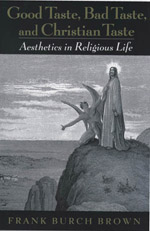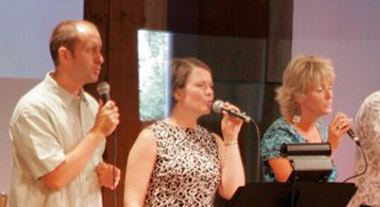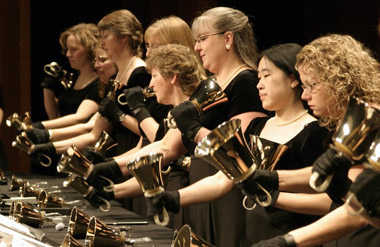 This article was first published in a somewhat longer form at the Calvin Institute of Christian Worship Web site. It is reprinted with permission. Review by Joan Huyser-Honig.
This article was first published in a somewhat longer form at the Calvin Institute of Christian Worship Web site. It is reprinted with permission. Review by Joan Huyser-Honig.
Here's a where-angels-fear-to-tread topic for your next family reunion. Just ask people what they think about Thomas Kinkade. Also known as "the painter of light," Kinkade has sold more work than any other painter in history.
Your aunt can't wait to see the blockbuster exhibit "From Abraham to Jesus," because it includes a bazaar selling Kinkade's new Impressions of Israel series. Your art major cousin shudders when your aunt explains that the painter's peaceful scenes remind her of God's love.
What do you do now? Leave the room, because questioning either one would be uncharitable? Jump into a polarizing argument about good and bad or high and low art? Frank Burch Brown suggests a third way. You can welcome diversity and creativity while exploring how an art form fits a specific worship context. "In some churches, the need to say no is not as strong as the need to say yes for a while. But how and what one responds to, aesthetically, can make a religious difference. And genuine impoverishment of taste can impoverish worship and the spiritual life as well," Burch Brown says. He wrote Good Taste, Bad Taste, and Christian Taste: Aesthetics in Religious Life and teaches religion and the arts at Christian Theological Seminary in Indianapolis.
Reasoning together
In years past, Burch Brown has been a church composer-in-residence, music director, and worship committee member. Since writing Religious Aesthetics (Princeton University press, 1989) for scholars, he has "dropped into the background in most actual, practical worship settings." That's partly because he wants space to simply worship, not analyze it. He also knows people sometimes feel afraid to talk about aesthetic response with him.

If a worship art form seems alien to you, then ask a "home user"
to describe how it helps them pray or experience God.
(STEVE HEYSER-HONIG)
"Taste is a biased and charged term. People relax when they realize the main point of my work is not to reject and judge. It is to encourage, help train, and mutually edify individuals and groups of worshipers engaged in the arts and arts leaders with religious commitments," Brown says.
Reasoning together about worship and the arts works best among people who agree:
-
It's elitist to assume that good taste or Christian taste belong only to one specific sort of community or art form.
-
There are multiple forms of good art, with many aims and modes of expression.
-
It's OK to explore values and criteria associated with arts and music as used in worship.
-
It's OK to ask about an art form's quality and appropriateness in a specific worship context.
"I want to cultivate an aesthetic that has teeth but no fangs," Burch Brown explains. "But you have to build trust before you can ask questions. Otherwise it's hard to move very far in conversation."
Honoring the other
Building trust starts with avoiding what Burch Brown in his first book calls "four forms of sinful taste." Obviously, art can enrich worship. But glorifying sinful tastes harms worship. Aesthetes idolize art for art's sake, often appreciating only creations that have little or no religious or moral meaning. Philistines focus so much on practical, moral, or religious categories that they overlook or dismiss artistic creations without those obvious messages.
Building trust also requires opening yourself to new experiences. "People are often skeptical that what they love (particularly in music) will ever change. We have a lot invested in the art and music that helped us know God and love church," Burch Brown says.

When you choose worship arts or reuse something created for another setting,
it's important to discuss what worship is for and what community is sharing a particular style.
(STEVE HEYSER-HONIG)
Yet working with Christian Theological Seminary students from 45 denominations and many cultures has shown him that it's possible to move from "please don't impose that music on me" to "now I see why you relate to that." Listening to someone describe how and why a piece helps them pray or worship, Burch Brown explains, "creates a middle space. Learning to relate to their tastes is a way to love them."
Asking worthwhile questions
Some reviewers complain that Burch Brown is so interested in not shutting down dialogue that he won't give specifics on what to avoid in worship arts. He does, however, write, "We cannot have it both ways. We cannot say that the kind and quality of art makes no religious difference … and also say that some art is especially conducive to being enjoyed 'in God.'"
And he offers twelve assumptions for testing Christian taste, such as "Not all kinds of good art and music are equally good for worship, let alone for every tradition or faith community."
Yet what appeals to some Christians appalls others. Countless visitors weep in the Precious Moments Chapel, which founder Sam Butcher says he modeled after the Sistine Chapel. Collectors of Thomas Kinkade resonate with his goal of doing visual evangelism that "portrays a world without a Fall." Burch Brown notes that Precious Moments and Kinkade art, along with some contemporary worship songs, use sentiment to trigger an immediate (and perhaps calculated) emotional response. By portraying only part of life, they indulge in a beautiful lie -- just as preachers do in sermons on Isaiah that use only what John Witvliet calls "the pretty texts ... all light, no shadows."
That's why Burch Brown calls the church to "art that the Christian can grow into but seldom out of. "Worship arts leaders may prefer to stick with what works or what most people like. In the long run, that choice is not theologically, pastorally, or artistically good for congregations.
Art complex enough to grow into can be the art of "less," such as gritty shape note music, or the abstract muted paintings that quiet the mind in ecumenical Rothko Chapel in Houston. It can also be the art of "more," with the "sonic exuberance" of the Sanctus from Bach's B minor Mass, or Antonio Gaudi's ornately extravagant (and unfinished) Sagrada Familia basilica in Barcelona.
Consider the context
Frank Burch Brown says he can imagine a good worship use for a lot of music that he doesn't personally care for. These good uses depend on at least three ways of considering the context.
First, worship planners and leaders will want to look at how well a piece of music (or other art form) fits within the flow of a specific worship service.What community is sharing this piece? What does this congregation believe worship is for? What worship principle does this piece further? How well does it relate to a current sermon series or liturgical season?
Second, Burch Brown talks about using mass media in worship. He agrees that commercial or advertising techniques can trigger instant effects in worship. And in Good Taste, Bad Taste, Christian Taste, he says it's "truly elitist (and cynical besides) to believe that popular arts are not concerned with questions of quality, or that they are strictly for the 'masses,' or that they must always be mere kitsch."
Third, Burch Brown addresses cross cultural context. "If your group has been silenced or marginalized, then using 'your' art in worship is liberating," he says. "But if you say that no one can make quality judgments outside their own community, then you cut off ecumenical or unity-in-diversity options. The wider community will notice possibilities and liabilities that 'home' users don't, because they are so familiar with it.
"In that process, the ways in which the work or style excels or falters (and almost every viable work or style has both strengths and weaknesses) become part of the larger cultural dialogue, often cross cultural," he says.
Listen to audio clips of Frank Burch Brown, browse resources for enriching and disciplining creativity in worship, and read discussion questions based on this article.